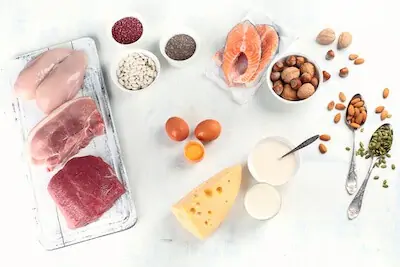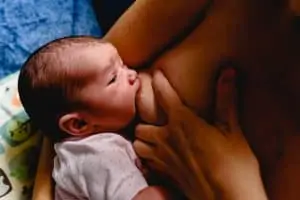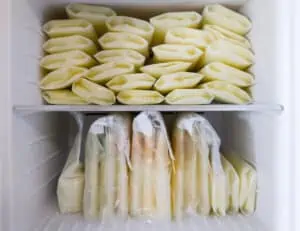Lately, it seems I’ve been getting more messages from mamas about low-fat content in breastmilk. If you’re wondering how to know if there’s not enough fat in your breastmilk, you’re definitely in the right place.
However, I want to assure you that your body is quite miraculous. Your breastmilk consists of foremilk and hindmilk. The hindmilk tends to be fattier, which I’ll discuss a little more in-depth below.
To increase fat in breast milk, you’ll want to read through the rest of this. It’s easy to make breastmilk fattier. You can try a few simple things, learn about the best foods for rich breastmilk, and see about supplements to increase fat in breast milk too.
But wait! Leslie, how do I know if I need to make breastmilk fattier? Read on, and you’ll know!
What affects the amount of fat in mom’s milk?
Your breastmilk naturally gets fattier throughout the day. The caloric content can vary widely throughout your feedings, though it’s about 22 kcal per ounce on average.
Additionally, how empty or full your breast is will affect the fat content. On average, it will be 1.2 grams per ounce. But a full breast has a lower fat content.
Here’s how quickly breast milk replenishes itself.
That’s because of the foremilk. It’s more watery. New mamas (myself included when I was a newbie!) don’t realize that you should keep the baby at the same breast until it empties before switching to the other breast.
In the end, when the breast feels empty, that’s where that really fatty hindmilk is. That’s the extra good stuff. It’s not to say your foremilk isn’t good for the baby. It is! But that fattier bit at the end is important for a baby to have.
Does food affect your breastmilk fat? It does, but not in the way you might think. What you eat doesn’t affect the fat or calories in your milk, but the types of fat in your milk can change based on what you eat.
What causes breastmilk to be fatty?
It’s so fascinating. That hindmilk is fattier because the fat globules are pushed out of the breast as your milk is suckled away.
I like to think of it as a milkshake. Do you know how the good stuff settles at the bottom of your glass? It’s the same kind of thing here. Your baby is getting that extra fatty good stuff from the hindmilk as the breast empties.
I know you feel like a boob slave since I did, too but hang in there. Newborns eat more slowly and take as long as 45 minutes per feeding. Tempting as it is, do not cut them short of that. Let them drain one breast first, then offer your other breast. Sometimes, your baby will take the second breast in the same feeding.
Sometimes, she won’t, though. And that’s ok. Just remember which one you used the last time and start with the other on the next feeding.
What happens if breast milk doesn’t have enough fat?
Simply put, if your baby isn’t getting enough fatty milk with each feeding, you will notice she’s not gaining weight as she should.

You can help this along by pumping. You can remove that foremilk, which is good stuff but has less fat. To separate your milk, pump your breasts with the pump. Once you get a good, steady flow for about 2 minutes, shut off the pump and store this foremilk in a separate container.
Then keep pumping until the flow stops, and then 2 more minutes beyond. Note this one as hindmilk on your bottle. If you ever think the baby isn’t gaining enough weight, you can feed her hindmilk to catch her up.
How do I know if my milk is fatty enough?
We worry enough as moms. We shouldn’t over-worry. That said, if you have wet and dirty diapers each day and your baby is growing and gaining weight, it’s safe to say your breastmilk is fatty enough.
When growth spurts happen, you may wonder if that oversupply of milk that comes from it is not balanced. But don’t. Because your body will naturally correct itself, feed baby, as she demands it, and your body will adjust accordingly.
If you’re still worried, though, you’ll know your baby is getting too much foremilk if you notice:
- Troublesome gassiness that upsets your baby
- Lots of crying and/or colicky symptoms
- Green or loose stools
- The baby wants to breastfeed more often than usual (and isn’t in a growth spurt)
That last point I want to clarify a bit…in growth spurts, your baby may feel like she’s stuck to your breast. But she will otherwise seem happy. Babies that seem comfortable and produce yellow stools are getting plenty of hindmilk.
Naturally, if you’re still not convinced, reach out to your doctor or lactation consultant.
When is breast milk the fattiest each day?
Have you noticed your baby cluster feeds in the evening and at night? That’s because your breastmilk increases in fat content gradually throughout the day.

Take advantage of this for the fattier, richer milk will satisfy them more and give them a longer stretch of sleep. Make sure you let your baby empty one breast fully and offer the second one. They may not need it each time since they may fall right asleep.
Is watery breast milk good for a baby?
I’ll answer this by saying ALL breastmilk is good for your baby. Both the foremilk and hindmilk play vital roles in a baby’s nutrition and must get both kinds.
Also, when the weather is warmer, milk tends to be more watery to help quench thirst. You don’t have to do a thing differently, though. Simply let your baby nurse from one breast until that breast is empty. They will get both the foremilk and hindmilk to satisfy their nutritional needs.
How much fat should breast milk have?
Unless you have a lab to help you determine this, you should know that the fat in your breastmilk will change with each feeding throughout the day. Time of day is a factor because your milk tends to be fattier in the evenings.
However, the other factor is emptying the breast. On average, the fat content in your milk will be 1.2 grams for every ounce.
Don’t sit and worry about the science of it, though. As I said before, your baby will get everything she needs from your milk if you let her drain one breast before moving on to the other.
Does my breast milk get fattier while my baby grows?
Your breastmilk changes to meet your baby’s needs. Their saliva contains chemicals that send a message through your body to adjust to the baby’s changing needs while growing.
That’s why the first milk your body makes is colostrum, that liquid gold that is like giving your baby an extra pop of immunity and strength.
Your breastmilk composition will change in every stage. So during a growth spurt, your body gets the message and increases the fat content in the milk to compensate for the growth. Isn’t that cool? I thought so!
Is fatty breast milk better for the baby?
Both the foremilk and hindmilk are essential for your baby. While the hindmilk is fattier and is vital for growth, that doesn’t mean you should throw away foremilk.
It means that you feed your baby accordingly, draining one breast before offering your other breast.
When pumping, make sure you sit patiently to drain the breast. I often had trouble pumping because it’s harder than nursing. My trick was to look at photos of my babies and focus on something else.
However, pay attention. Don’t be like me and forget you’re pumping and have it spill out the top of the bottle. D’oh!
How to increase the fat content of breast milk?
Again, the breastmilk your body makes is important, from the first suckle to the moment they pull off the breast. Getting both parts of this milk is important though the fattier stuff helps the brain and nervous system development, so make sure you’re not ending feedings before you empty your breast.
If you want to increase the fat content of your breast milk because your baby isn’t gaining enough weight or seems deeply agitated, here’s how to do it…
Drain those boobies
The number one way to increase fat in breastmilk is to breastfeed one breast until it is empty or pump out the foremilk. You should be feeding off both breasts but let baby lead.
Your baby will nurse at the duration they want as well as frequency. This way, she gets both the foremilk and hindmilk from both sides. When she suckles, the fats in the milk stick on the milk duct walls and let the foremilk out first. You do not want to switch her until she pulls away herself.
Grab a book, watch a show, and otherwise distract yourself while your baby nurses and she’ll do the rest for you.
Try a massage
Massaging your breasts and doing breast compressions can improve the breast milk flow. Simply hold your breast and squeeze it gently over and over. These compressions help the fatty parts of the milk move to the nipples. This ensures letdown and frees up ducts, so milk flows smoothly.
Have more nursing sessions

With more frequent feedings where you drain one or both boobs, your baby will get more of that fatty milk. However, some babies may get fuller sooner than you anticipate, and that’s ok. Pump out the rest of your milk and save that hindmilk. Your husband or a caretaker can feed it to her later to give you a break.
Talk to a lactation consultant
If you’re trying all these things, but the baby isn’t gaining enough weight, see the doctor and meet with a lactation consultant. They can help you get to the bottom of what’s going on so your baby can thrive.
What foods increase fat in breast milk?
Taking care of yourself will ensure your baby has the best start in life. Unlike formula-fed babies, breastfed babies get all kinds of nutrients from your milk.
To give your baby the best start, here are a few tips…
- Eat more protein
Eggs, nuts, cheese, chicken, milk, and fish are just some examples of what to put on your plate. You can also try protein powder if you’re not a big protein person. But your body needs this nutrient, so don’t skip it.

- Try sunflower lecithin
Some say that sunflower lecithin can increase fatty acids in breast milk and unclog milk ducts. It’s considered safe to use, too, though ask your doctor first!
- Consider lactation cookies
Oh man, I would have loved these lactation cookies! They look great, and I know a few mamas that swear by them. They didn’t have them when my babies were babies, but they have milk thistle, which is said to help the supply of milk.
- Be about balance
Maintaining a balanced diet is a surefire way to have nutritious breastmilk for a baby. Ensure you get those proteins, fresh fruits and veggies, whole grains, and healthy fats.
- Eat the right fats
Fats are great for you. Well, the right kinds anyway. Monounsaturated and polyunsaturated fats are most crucial for brain development. These are in seeds, nuts, fish, and vegetable oils.
Final thoughts on making breastmilk fattier…
I ate nothing special when I was nursing both my babies. All I did was follow the advice of my breastfeeding coach and hang in there. I remember wanting to scream and run off after noting I was nursing my eldest for 45 minutes at a time when she was a newborn.
I’d give her both breasts, and finally, she’d let go. Then I felt like I had 10 minutes to myself before she wanted to eat again. I almost gave up.
I’m glad I didn’t, though, and I hope you keep at it too. Yes, it’s challenging work, but they start eating more quickly soon enough. Give it 4 to 6 weeks because your baby will never need you more than they do right now.
The biggest thing to remember here is to empty each breast and take care of your nutrition. These factors will ensure your baby’s best possible milk supply and fattiness.
Leslie Berry lives with her husband and two young daughters in Los Altos, California, where she loves helping other moms get comfortable with motherhood and embracing the insanity with facts peppered with laughs.
She loves eating too much sushi, exercising, and jamming out on her Fender. Read more about Leslie here.






